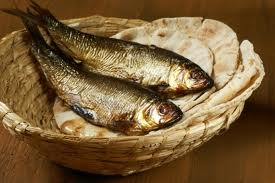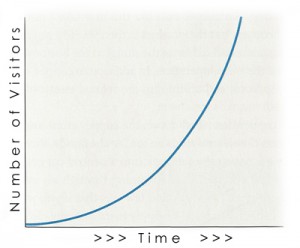Doubling Your Readership Base: A Power Tip That Gets You Long-Term Results

Our marketing goal is doubling – both readership and Opt-Ins. (Photo of a Doubling Dial from a backgammon game.)
Over the last month (shockingly, it has been that long), I’ve been putting into practice the advice that I gave in last month’s blog, Creating the Elephant for Others to Eat (One Bite at a Time), subtitled: Creating Your Next Big Project (And Staying Sane, and Having a Life, While Doing So).
The result? I’ve been doubling my blog readership – in each of my three primary blogs – at a rate of about one doubling per every two months.
Not only that, I’ve been doubling my Opt-Ins at about the same rate.
Loaves and Fishes: Feeding Your Tribe

Loaves and fishes: feeding your tribe (your Opt-In group) means regularly giving them content that meets their needs.
If you are an emerging thought-leader, then you’re starting to build a tribe.
Your tribe consists of those people who are following you, with some degree of closeness.
Every single person in your tribe wants to be fed.
The three types of people in your tribe are:
- Loyal disciples: These are people who are your advocates; they’re your evangelists. They’ll read or watch everything that you put out. They’ll forward your emails to their friends. They buy your books, take your workshops, listen to your TED(TM) talks on the way to work. Outside of your own advisers, these are the closest of your inner support circle.
- Official Tribe Members: These people have taken the big step of giving you their name and email address on one of your Opt-In forms, which you host on your website. (I’ll put in an Opt-In form in the right-hand sidebar shortly, and will update this blog to reflect that. Until then, see the Opt-In form in the very first post I wrote for this blog: Surviving the Valley of Death. Giving you a name and email address is a huge gesture of trust and intimacy. It means that these people want to hear from you.
- Lurkers: Only a fraction of those who come to your website will Opt-In. The majority will scan and move on. A good number, though, will take an intermediary step. They’ll put you on their automatic feed (RSS), or keep checking your blog. They won’t come forward and identify themselves with you, but they’re there. These people also want to be fed.
This brings me to the “loaves and fishes” strategy. You feed your tribe by writing blogs – or producing content (YouTube vids, Podcasts, etc.) – that is helpful to your people; material that meets their needs.
Just like Jesus did with his disciples, you give your loaves and fishes away for free.
It’s like providing free food samples at an upscale grocery store. If you taste the cheese and like it, you’ll buy some.
Similarly, you feed your tribe. Regular content keeps them fed.
If You’re Leading a Tribe, then You’re a Hierophant
The best marketers are actually thought-leaders; really, they are Hierophants. I introduced the Hierophant notion in last month’s blog, Creating the Elephant for Others to Eat (One Bite at a Time). (That blog has lots of links to relevant posts that will help build out the Hierophant concept.)
Essentially, a Hierophant is a transformational teacher; a guru or guide of the highest order.
A Hierophant is compelled to teach. Marketing – creating a revenue stream – these are all good results of the teaching process. However, the Hierophant starts with the intention of teaching and transforming lives; the money and social influence are by-products.
Example Hierophants include Yoda and Obi-Wan Kenobi (from Star Wars) and Mr. Miyagi (from the Karate Kid).
One of the most effective ways that a Hierophant can teach is by producing web-based content; blogs, YouTube vids, and other easily-accessed material.
Revenue Relates to Opt-Ins, Opt-Ins Relate to Readership, the Goal is Doubling
If you’re aware of current wisdom in the internet-based marketing arena, you know that business revenue correlates directly with Opt-Ins. The actual amount will depend exactly on what you have to offer as revenue-producing services and products, but the notion makes sense:

Exponential growth gives you massive results over time.
The more people in your tribe (your Opt-In groups), the more people who will likely pay attention to your offers.
In the last blog, I introduced intralinking as a power tip for building your readership. In this post, I’ll give an intralinking example. In subsequent posts, I’ll let you know how well its worked at increasing readership (and consequently, Opt-Ins).
Intralinking: One Way to Influence Your Doubling Rate
Intralinking means that you use links inside your blog post to link to other posts, from within the same blog. I’ve done that several times in this post.
For a really great example, see the post that I wrote yesterday for The Unveiling Journey. In Six-Year Anniversary for The Unveiling Journey Blog Series: Six Top Blog Posts Over Past Six Years, I linked to the most popular blogs on that site, from a six-year history of blog posting.
Three ways in which this helps grow readership:
- Evergreen blogs become stronger: The selected blog posts (those to which I intralinked in this recent Unveiling blog post) have been getting ongoing readership, months and even years after initial posting. That means that they have the most valuable content for readers. Giving readers the “top value” (and even my recommendation as to where they should start) is giving them extra-special loaves and fishes; it puts the highest-value content in one post, and saves them time. This increases trust, which increases following.
- Increase likelihood of back links from other sources: Certain readers will want to put backlinks in their own websites and blogs to the best content for their own tribes. Obviously, no one can point to all of your blogs. But the occasional high-value blog post (one with lots of really good intralinks) will get more attention from those who put out summary blogs with backlinks. (An example? I’m linking to it here! Once again, the link is: Six-Year Anniversary for The Unveiling Journey Blog Series: Six Top Blog Posts Over Past Six Years.)
- Intralinking invites readers to keep on reading: If a reader comes in and feels that they’re on a roll with your posts, they’ll continue for a while. Intralinking lets them follow your thoughts throughout your blog and creates a stronger internal “mesh” within your blog series. That way, no one post is stand-alone; each becomes part of a cohesive and attractive whole.

